Economics Assignment: Negative Externalities and Market Outcomes
VerifiedAdded on 2022/12/27
|16
|4324
|1
Essay
AI Summary
This economics essay examines negative externalities, defined as costs borne by third parties in economic transactions, focusing on their impact on market outcomes. It explores the case for government intervention, detailing how taxes, charges, and regulations can be used to correct these externalities, along with their respective advantages and disadvantages, supported by real-life examples. The essay then presents a case study of negative externalities in Australia's agricultural sector, specifically focusing on the environmental impacts of irrigation. It analyzes the effects of these externalities on market outcomes, including deadweight loss, and discusses the Australian government's current approaches to mitigating the issues. Furthermore, the essay proposes additional options for addressing negative externalities in the case study and identifies the relevant market structure based on key characteristics. The analysis incorporates academic research, real data, and economic principles to provide a comprehensive understanding of the subject matter.
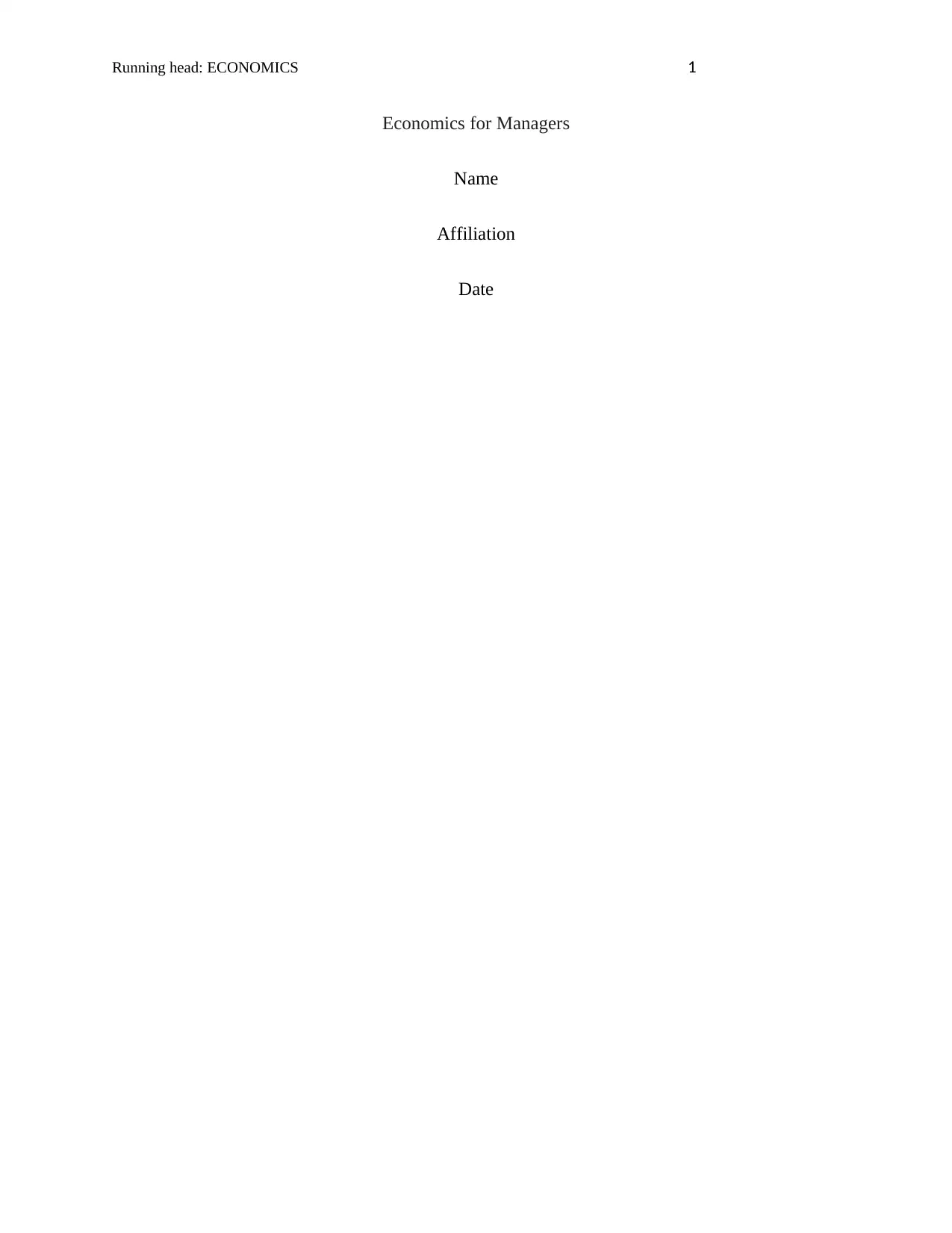
Running head: ECONOMICS 1
Economics for Managers
Name
Affiliation
Date
Economics for Managers
Name
Affiliation
Date
Paraphrase This Document
Need a fresh take? Get an instant paraphrase of this document with our AI Paraphraser
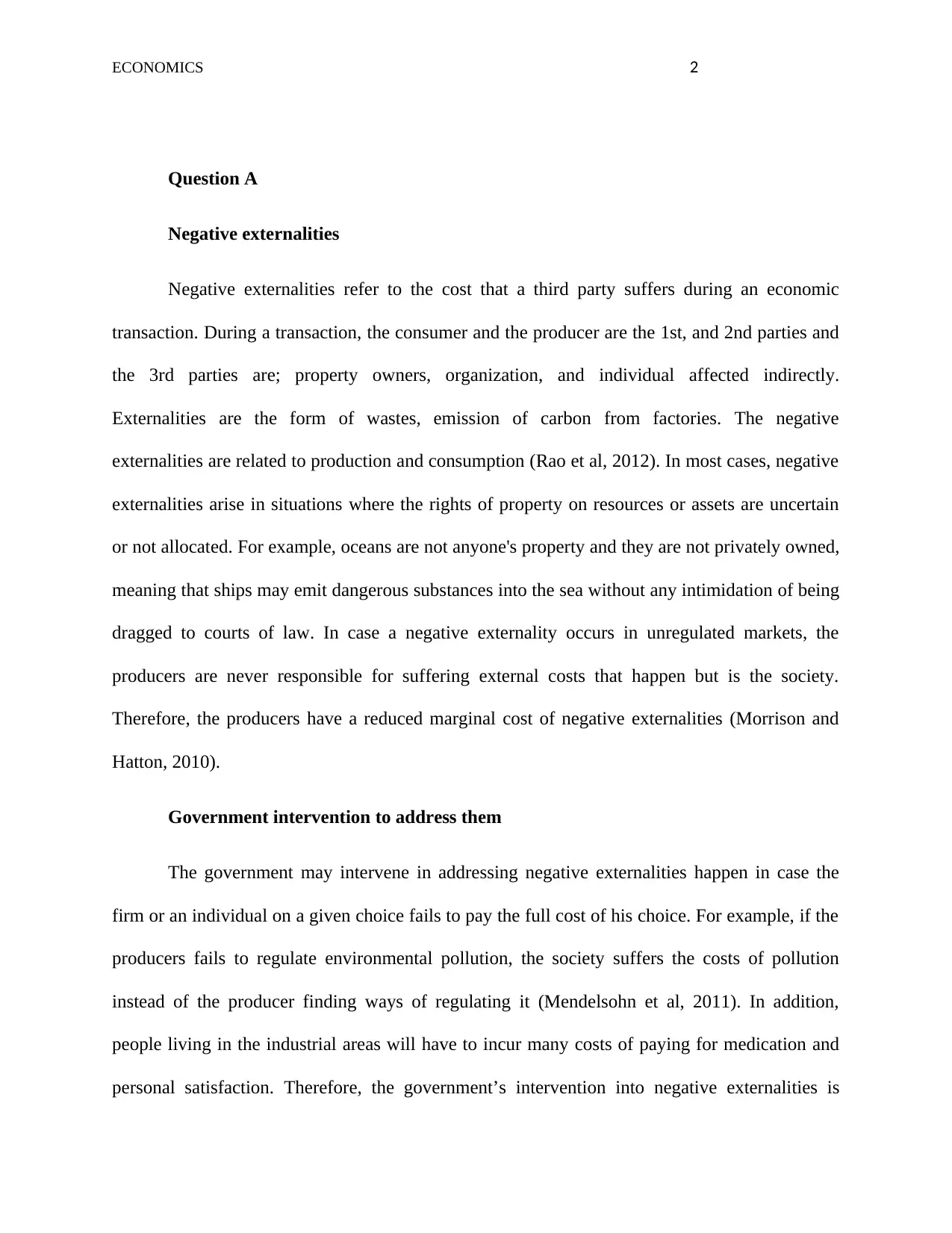
ECONOMICS 2
Question A
Negative externalities
Negative externalities refer to the cost that a third party suffers during an economic
transaction. During a transaction, the consumer and the producer are the 1st, and 2nd parties and
the 3rd parties are; property owners, organization, and individual affected indirectly.
Externalities are the form of wastes, emission of carbon from factories. The negative
externalities are related to production and consumption (Rao et al, 2012). In most cases, negative
externalities arise in situations where the rights of property on resources or assets are uncertain
or not allocated. For example, oceans are not anyone's property and they are not privately owned,
meaning that ships may emit dangerous substances into the sea without any intimidation of being
dragged to courts of law. In case a negative externality occurs in unregulated markets, the
producers are never responsible for suffering external costs that happen but is the society.
Therefore, the producers have a reduced marginal cost of negative externalities (Morrison and
Hatton, 2010).
Government intervention to address them
The government may intervene in addressing negative externalities happen in case the
firm or an individual on a given choice fails to pay the full cost of his choice. For example, if the
producers fails to regulate environmental pollution, the society suffers the costs of pollution
instead of the producer finding ways of regulating it (Mendelsohn et al, 2011). In addition,
people living in the industrial areas will have to incur many costs of paying for medication and
personal satisfaction. Therefore, the government’s intervention into negative externalities is
Question A
Negative externalities
Negative externalities refer to the cost that a third party suffers during an economic
transaction. During a transaction, the consumer and the producer are the 1st, and 2nd parties and
the 3rd parties are; property owners, organization, and individual affected indirectly.
Externalities are the form of wastes, emission of carbon from factories. The negative
externalities are related to production and consumption (Rao et al, 2012). In most cases, negative
externalities arise in situations where the rights of property on resources or assets are uncertain
or not allocated. For example, oceans are not anyone's property and they are not privately owned,
meaning that ships may emit dangerous substances into the sea without any intimidation of being
dragged to courts of law. In case a negative externality occurs in unregulated markets, the
producers are never responsible for suffering external costs that happen but is the society.
Therefore, the producers have a reduced marginal cost of negative externalities (Morrison and
Hatton, 2010).
Government intervention to address them
The government may intervene in addressing negative externalities happen in case the
firm or an individual on a given choice fails to pay the full cost of his choice. For example, if the
producers fails to regulate environmental pollution, the society suffers the costs of pollution
instead of the producer finding ways of regulating it (Mendelsohn et al, 2011). In addition,
people living in the industrial areas will have to incur many costs of paying for medication and
personal satisfaction. Therefore, the government’s intervention into negative externalities is
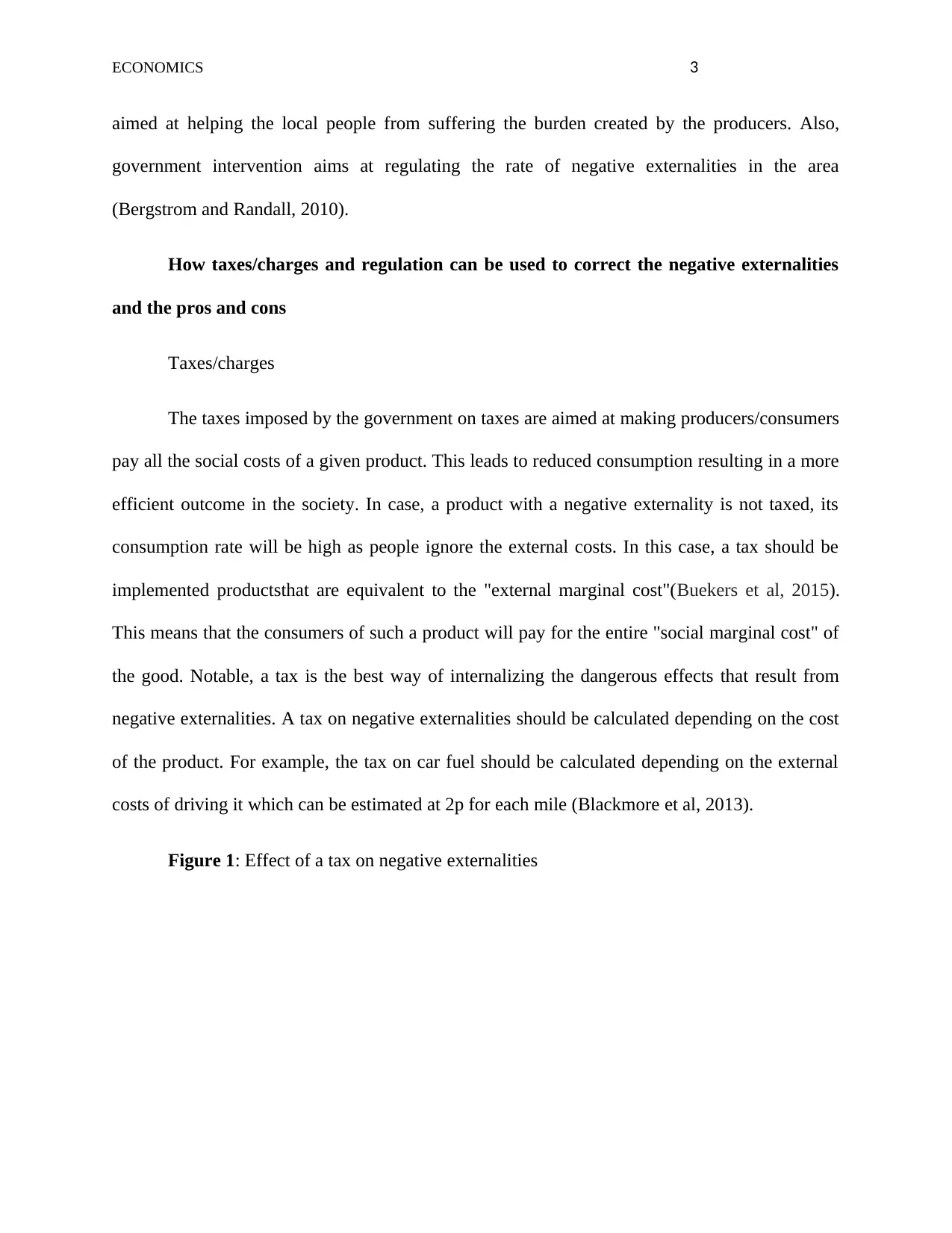
ECONOMICS 3
aimed at helping the local people from suffering the burden created by the producers. Also,
government intervention aims at regulating the rate of negative externalities in the area
(Bergstrom and Randall, 2010).
How taxes/charges and regulation can be used to correct the negative externalities
and the pros and cons
Taxes/charges
The taxes imposed by the government on taxes are aimed at making producers/consumers
pay all the social costs of a given product. This leads to reduced consumption resulting in a more
efficient outcome in the society. In case, a product with a negative externality is not taxed, its
consumption rate will be high as people ignore the external costs. In this case, a tax should be
implemented productsthat are equivalent to the "external marginal cost"(Buekers et al, 2015).
This means that the consumers of such a product will pay for the entire "social marginal cost" of
the good. Notable, a tax is the best way of internalizing the dangerous effects that result from
negative externalities. A tax on negative externalities should be calculated depending on the cost
of the product. For example, the tax on car fuel should be calculated depending on the external
costs of driving it which can be estimated at 2p for each mile (Blackmore et al, 2013).
Figure 1: Effect of a tax on negative externalities
aimed at helping the local people from suffering the burden created by the producers. Also,
government intervention aims at regulating the rate of negative externalities in the area
(Bergstrom and Randall, 2010).
How taxes/charges and regulation can be used to correct the negative externalities
and the pros and cons
Taxes/charges
The taxes imposed by the government on taxes are aimed at making producers/consumers
pay all the social costs of a given product. This leads to reduced consumption resulting in a more
efficient outcome in the society. In case, a product with a negative externality is not taxed, its
consumption rate will be high as people ignore the external costs. In this case, a tax should be
implemented productsthat are equivalent to the "external marginal cost"(Buekers et al, 2015).
This means that the consumers of such a product will pay for the entire "social marginal cost" of
the good. Notable, a tax is the best way of internalizing the dangerous effects that result from
negative externalities. A tax on negative externalities should be calculated depending on the cost
of the product. For example, the tax on car fuel should be calculated depending on the external
costs of driving it which can be estimated at 2p for each mile (Blackmore et al, 2013).
Figure 1: Effect of a tax on negative externalities
⊘ This is a preview!⊘
Do you want full access?
Subscribe today to unlock all pages.

Trusted by 1+ million students worldwide
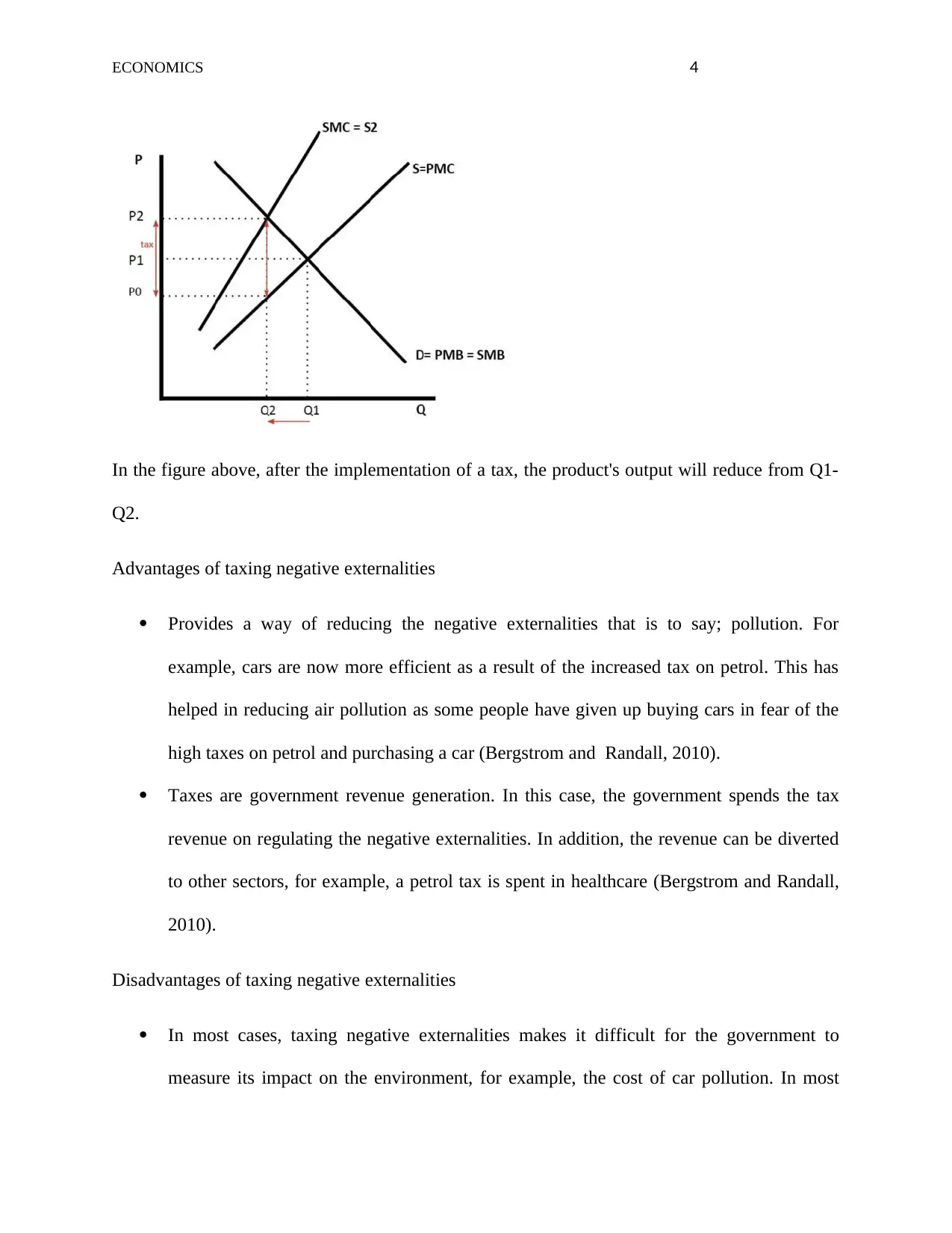
ECONOMICS 4
In the figure above, after the implementation of a tax, the product's output will reduce from Q1-
Q2.
Advantages of taxing negative externalities
Provides a way of reducing the negative externalities that is to say; pollution. For
example, cars are now more efficient as a result of the increased tax on petrol. This has
helped in reducing air pollution as some people have given up buying cars in fear of the
high taxes on petrol and purchasing a car (Bergstrom and Randall, 2010).
Taxes are government revenue generation. In this case, the government spends the tax
revenue on regulating the negative externalities. In addition, the revenue can be diverted
to other sectors, for example, a petrol tax is spent in healthcare (Bergstrom and Randall,
2010).
Disadvantages of taxing negative externalities
In most cases, taxing negative externalities makes it difficult for the government to
measure its impact on the environment, for example, the cost of car pollution. In most
In the figure above, after the implementation of a tax, the product's output will reduce from Q1-
Q2.
Advantages of taxing negative externalities
Provides a way of reducing the negative externalities that is to say; pollution. For
example, cars are now more efficient as a result of the increased tax on petrol. This has
helped in reducing air pollution as some people have given up buying cars in fear of the
high taxes on petrol and purchasing a car (Bergstrom and Randall, 2010).
Taxes are government revenue generation. In this case, the government spends the tax
revenue on regulating the negative externalities. In addition, the revenue can be diverted
to other sectors, for example, a petrol tax is spent in healthcare (Bergstrom and Randall,
2010).
Disadvantages of taxing negative externalities
In most cases, taxing negative externalities makes it difficult for the government to
measure its impact on the environment, for example, the cost of car pollution. In most
Paraphrase This Document
Need a fresh take? Get an instant paraphrase of this document with our AI Paraphraser
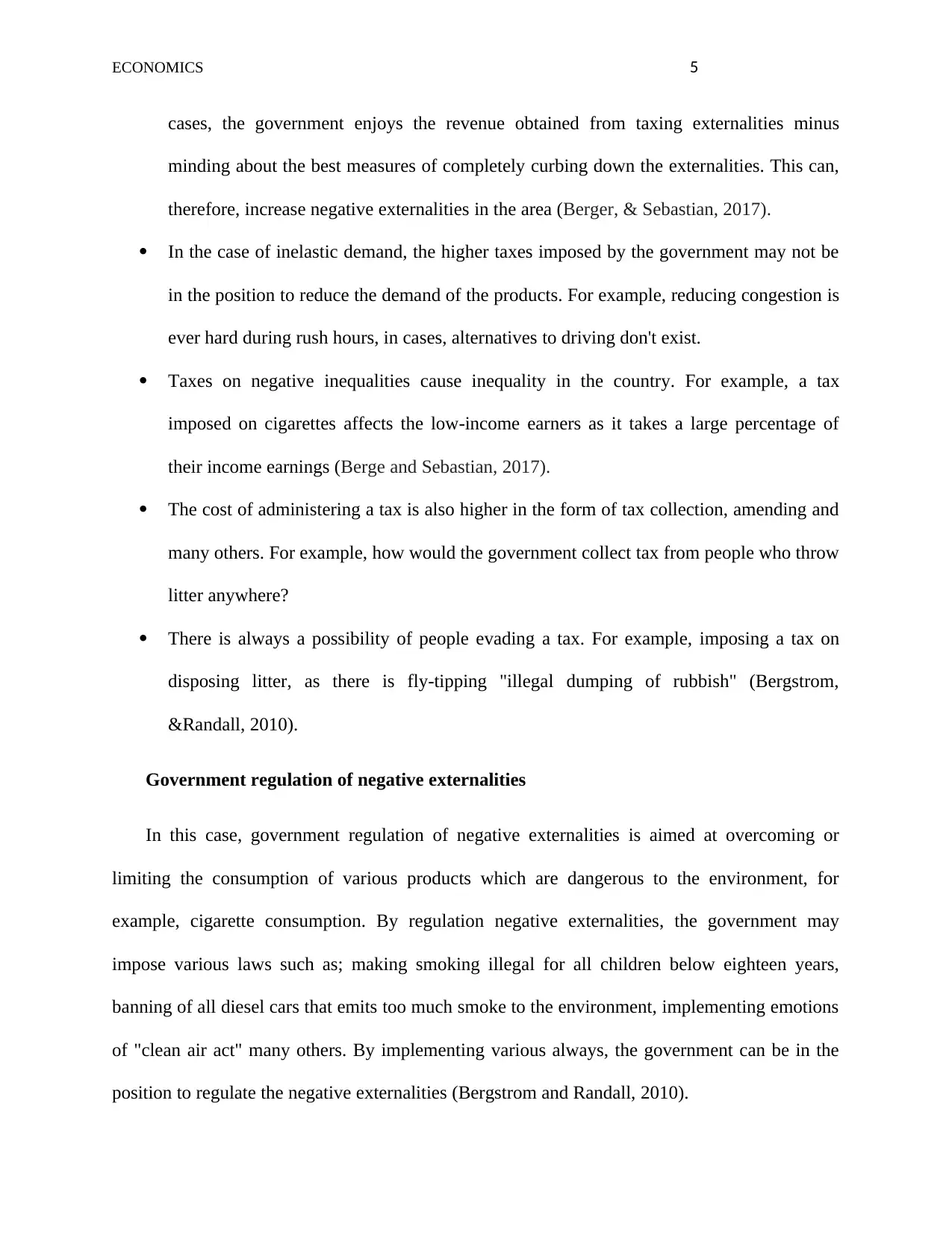
ECONOMICS 5
cases, the government enjoys the revenue obtained from taxing externalities minus
minding about the best measures of completely curbing down the externalities. This can,
therefore, increase negative externalities in the area (Berger, & Sebastian, 2017).
In the case of inelastic demand, the higher taxes imposed by the government may not be
in the position to reduce the demand of the products. For example, reducing congestion is
ever hard during rush hours, in cases, alternatives to driving don't exist.
Taxes on negative inequalities cause inequality in the country. For example, a tax
imposed on cigarettes affects the low-income earners as it takes a large percentage of
their income earnings (Berge and Sebastian, 2017).
The cost of administering a tax is also higher in the form of tax collection, amending and
many others. For example, how would the government collect tax from people who throw
litter anywhere?
There is always a possibility of people evading a tax. For example, imposing a tax on
disposing litter, as there is fly-tipping "illegal dumping of rubbish" (Bergstrom,
&Randall, 2010).
Government regulation of negative externalities
In this case, government regulation of negative externalities is aimed at overcoming or
limiting the consumption of various products which are dangerous to the environment, for
example, cigarette consumption. By regulation negative externalities, the government may
impose various laws such as; making smoking illegal for all children below eighteen years,
banning of all diesel cars that emits too much smoke to the environment, implementing emotions
of "clean air act" many others. By implementing various always, the government can be in the
position to regulate the negative externalities (Bergstrom and Randall, 2010).
cases, the government enjoys the revenue obtained from taxing externalities minus
minding about the best measures of completely curbing down the externalities. This can,
therefore, increase negative externalities in the area (Berger, & Sebastian, 2017).
In the case of inelastic demand, the higher taxes imposed by the government may not be
in the position to reduce the demand of the products. For example, reducing congestion is
ever hard during rush hours, in cases, alternatives to driving don't exist.
Taxes on negative inequalities cause inequality in the country. For example, a tax
imposed on cigarettes affects the low-income earners as it takes a large percentage of
their income earnings (Berge and Sebastian, 2017).
The cost of administering a tax is also higher in the form of tax collection, amending and
many others. For example, how would the government collect tax from people who throw
litter anywhere?
There is always a possibility of people evading a tax. For example, imposing a tax on
disposing litter, as there is fly-tipping "illegal dumping of rubbish" (Bergstrom,
&Randall, 2010).
Government regulation of negative externalities
In this case, government regulation of negative externalities is aimed at overcoming or
limiting the consumption of various products which are dangerous to the environment, for
example, cigarette consumption. By regulation negative externalities, the government may
impose various laws such as; making smoking illegal for all children below eighteen years,
banning of all diesel cars that emits too much smoke to the environment, implementing emotions
of "clean air act" many others. By implementing various always, the government can be in the
position to regulate the negative externalities (Bergstrom and Randall, 2010).
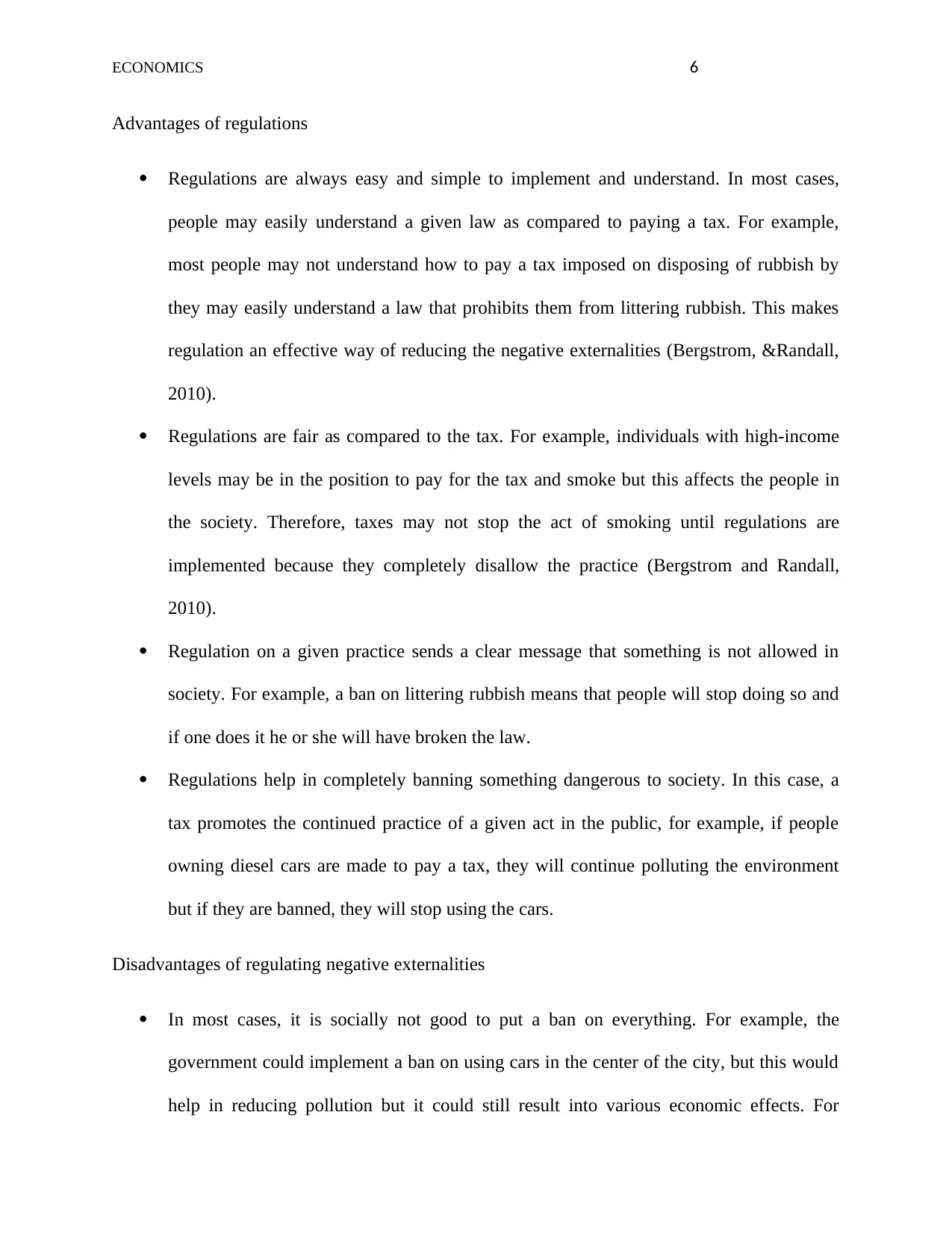
ECONOMICS 6
Advantages of regulations
Regulations are always easy and simple to implement and understand. In most cases,
people may easily understand a given law as compared to paying a tax. For example,
most people may not understand how to pay a tax imposed on disposing of rubbish by
they may easily understand a law that prohibits them from littering rubbish. This makes
regulation an effective way of reducing the negative externalities (Bergstrom, &Randall,
2010).
Regulations are fair as compared to the tax. For example, individuals with high-income
levels may be in the position to pay for the tax and smoke but this affects the people in
the society. Therefore, taxes may not stop the act of smoking until regulations are
implemented because they completely disallow the practice (Bergstrom and Randall,
2010).
Regulation on a given practice sends a clear message that something is not allowed in
society. For example, a ban on littering rubbish means that people will stop doing so and
if one does it he or she will have broken the law.
Regulations help in completely banning something dangerous to society. In this case, a
tax promotes the continued practice of a given act in the public, for example, if people
owning diesel cars are made to pay a tax, they will continue polluting the environment
but if they are banned, they will stop using the cars.
Disadvantages of regulating negative externalities
In most cases, it is socially not good to put a ban on everything. For example, the
government could implement a ban on using cars in the center of the city, but this would
help in reducing pollution but it could still result into various economic effects. For
Advantages of regulations
Regulations are always easy and simple to implement and understand. In most cases,
people may easily understand a given law as compared to paying a tax. For example,
most people may not understand how to pay a tax imposed on disposing of rubbish by
they may easily understand a law that prohibits them from littering rubbish. This makes
regulation an effective way of reducing the negative externalities (Bergstrom, &Randall,
2010).
Regulations are fair as compared to the tax. For example, individuals with high-income
levels may be in the position to pay for the tax and smoke but this affects the people in
the society. Therefore, taxes may not stop the act of smoking until regulations are
implemented because they completely disallow the practice (Bergstrom and Randall,
2010).
Regulation on a given practice sends a clear message that something is not allowed in
society. For example, a ban on littering rubbish means that people will stop doing so and
if one does it he or she will have broken the law.
Regulations help in completely banning something dangerous to society. In this case, a
tax promotes the continued practice of a given act in the public, for example, if people
owning diesel cars are made to pay a tax, they will continue polluting the environment
but if they are banned, they will stop using the cars.
Disadvantages of regulating negative externalities
In most cases, it is socially not good to put a ban on everything. For example, the
government could implement a ban on using cars in the center of the city, but this would
help in reducing pollution but it could still result into various economic effects. For
⊘ This is a preview!⊘
Do you want full access?
Subscribe today to unlock all pages.

Trusted by 1+ million students worldwide
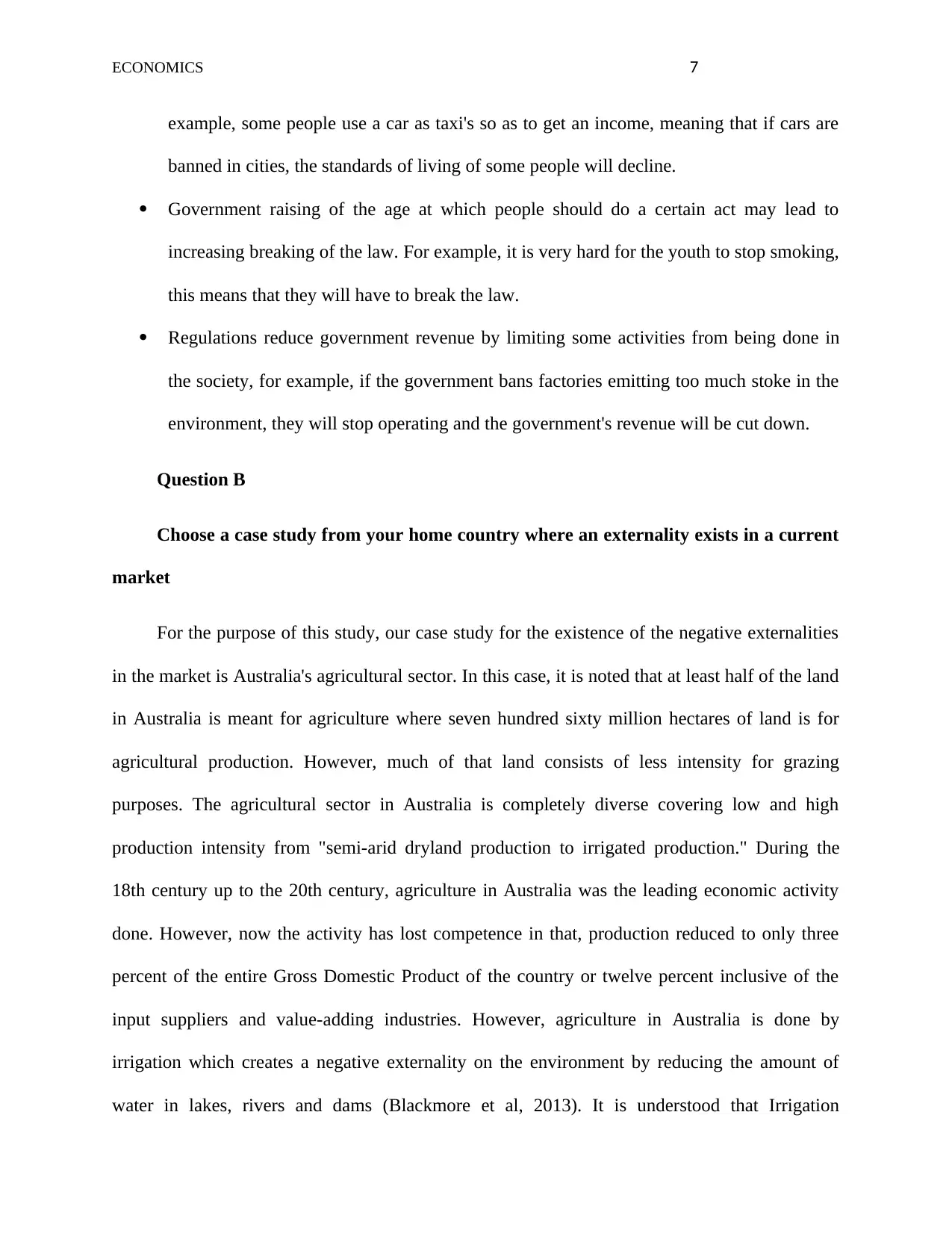
ECONOMICS 7
example, some people use a car as taxi's so as to get an income, meaning that if cars are
banned in cities, the standards of living of some people will decline.
Government raising of the age at which people should do a certain act may lead to
increasing breaking of the law. For example, it is very hard for the youth to stop smoking,
this means that they will have to break the law.
Regulations reduce government revenue by limiting some activities from being done in
the society, for example, if the government bans factories emitting too much stoke in the
environment, they will stop operating and the government's revenue will be cut down.
Question B
Choose a case study from your home country where an externality exists in a current
market
For the purpose of this study, our case study for the existence of the negative externalities
in the market is Australia's agricultural sector. In this case, it is noted that at least half of the land
in Australia is meant for agriculture where seven hundred sixty million hectares of land is for
agricultural production. However, much of that land consists of less intensity for grazing
purposes. The agricultural sector in Australia is completely diverse covering low and high
production intensity from "semi-arid dryland production to irrigated production." During the
18th century up to the 20th century, agriculture in Australia was the leading economic activity
done. However, now the activity has lost competence in that, production reduced to only three
percent of the entire Gross Domestic Product of the country or twelve percent inclusive of the
input suppliers and value-adding industries. However, agriculture in Australia is done by
irrigation which creates a negative externality on the environment by reducing the amount of
water in lakes, rivers and dams (Blackmore et al, 2013). It is understood that Irrigation
example, some people use a car as taxi's so as to get an income, meaning that if cars are
banned in cities, the standards of living of some people will decline.
Government raising of the age at which people should do a certain act may lead to
increasing breaking of the law. For example, it is very hard for the youth to stop smoking,
this means that they will have to break the law.
Regulations reduce government revenue by limiting some activities from being done in
the society, for example, if the government bans factories emitting too much stoke in the
environment, they will stop operating and the government's revenue will be cut down.
Question B
Choose a case study from your home country where an externality exists in a current
market
For the purpose of this study, our case study for the existence of the negative externalities
in the market is Australia's agricultural sector. In this case, it is noted that at least half of the land
in Australia is meant for agriculture where seven hundred sixty million hectares of land is for
agricultural production. However, much of that land consists of less intensity for grazing
purposes. The agricultural sector in Australia is completely diverse covering low and high
production intensity from "semi-arid dryland production to irrigated production." During the
18th century up to the 20th century, agriculture in Australia was the leading economic activity
done. However, now the activity has lost competence in that, production reduced to only three
percent of the entire Gross Domestic Product of the country or twelve percent inclusive of the
input suppliers and value-adding industries. However, agriculture in Australia is done by
irrigation which creates a negative externality on the environment by reducing the amount of
water in lakes, rivers and dams (Blackmore et al, 2013). It is understood that Irrigation
Paraphrase This Document
Need a fresh take? Get an instant paraphrase of this document with our AI Paraphraser
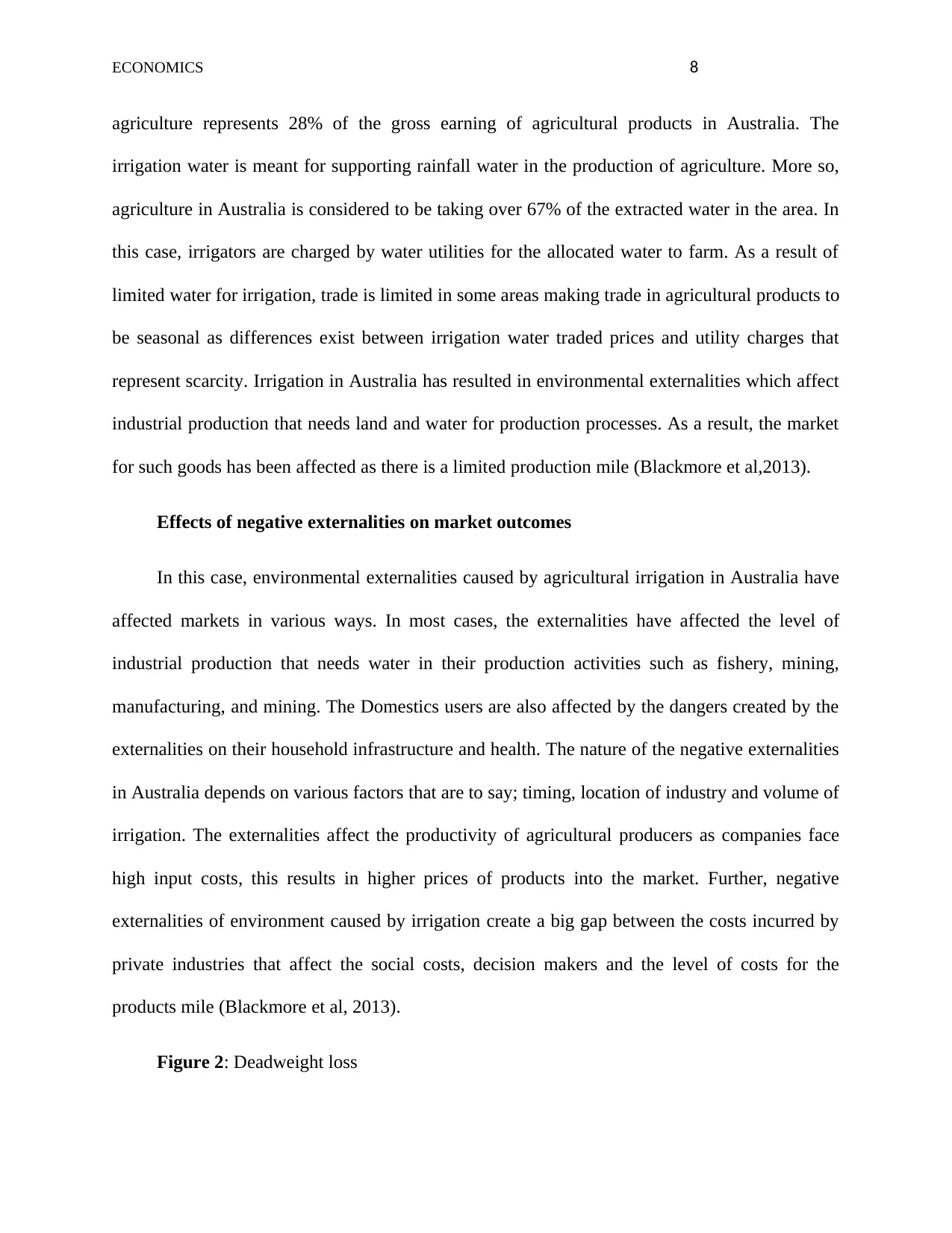
ECONOMICS 8
agriculture represents 28% of the gross earning of agricultural products in Australia. The
irrigation water is meant for supporting rainfall water in the production of agriculture. More so,
agriculture in Australia is considered to be taking over 67% of the extracted water in the area. In
this case, irrigators are charged by water utilities for the allocated water to farm. As a result of
limited water for irrigation, trade is limited in some areas making trade in agricultural products to
be seasonal as differences exist between irrigation water traded prices and utility charges that
represent scarcity. Irrigation in Australia has resulted in environmental externalities which affect
industrial production that needs land and water for production processes. As a result, the market
for such goods has been affected as there is a limited production mile (Blackmore et al,2013).
Effects of negative externalities on market outcomes
In this case, environmental externalities caused by agricultural irrigation in Australia have
affected markets in various ways. In most cases, the externalities have affected the level of
industrial production that needs water in their production activities such as fishery, mining,
manufacturing, and mining. The Domestics users are also affected by the dangers created by the
externalities on their household infrastructure and health. The nature of the negative externalities
in Australia depends on various factors that are to say; timing, location of industry and volume of
irrigation. The externalities affect the productivity of agricultural producers as companies face
high input costs, this results in higher prices of products into the market. Further, negative
externalities of environment caused by irrigation create a big gap between the costs incurred by
private industries that affect the social costs, decision makers and the level of costs for the
products mile (Blackmore et al, 2013).
Figure 2: Deadweight loss
agriculture represents 28% of the gross earning of agricultural products in Australia. The
irrigation water is meant for supporting rainfall water in the production of agriculture. More so,
agriculture in Australia is considered to be taking over 67% of the extracted water in the area. In
this case, irrigators are charged by water utilities for the allocated water to farm. As a result of
limited water for irrigation, trade is limited in some areas making trade in agricultural products to
be seasonal as differences exist between irrigation water traded prices and utility charges that
represent scarcity. Irrigation in Australia has resulted in environmental externalities which affect
industrial production that needs land and water for production processes. As a result, the market
for such goods has been affected as there is a limited production mile (Blackmore et al,2013).
Effects of negative externalities on market outcomes
In this case, environmental externalities caused by agricultural irrigation in Australia have
affected markets in various ways. In most cases, the externalities have affected the level of
industrial production that needs water in their production activities such as fishery, mining,
manufacturing, and mining. The Domestics users are also affected by the dangers created by the
externalities on their household infrastructure and health. The nature of the negative externalities
in Australia depends on various factors that are to say; timing, location of industry and volume of
irrigation. The externalities affect the productivity of agricultural producers as companies face
high input costs, this results in higher prices of products into the market. Further, negative
externalities of environment caused by irrigation create a big gap between the costs incurred by
private industries that affect the social costs, decision makers and the level of costs for the
products mile (Blackmore et al, 2013).
Figure 2: Deadweight loss
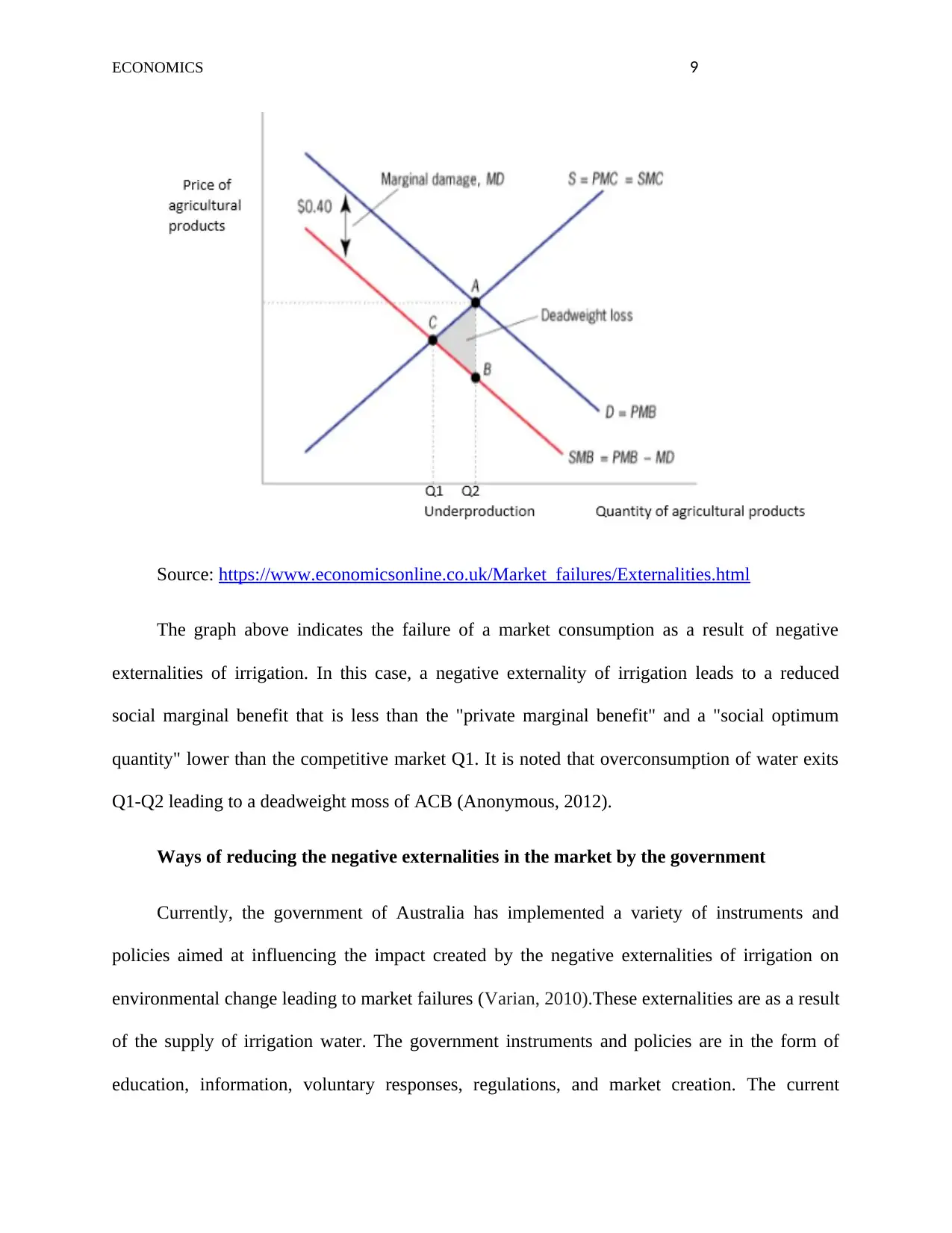
ECONOMICS 9
Source: https://www.economicsonline.co.uk/Market_failures/Externalities.html
The graph above indicates the failure of a market consumption as a result of negative
externalities of irrigation. In this case, a negative externality of irrigation leads to a reduced
social marginal benefit that is less than the "private marginal benefit" and a "social optimum
quantity" lower than the competitive market Q1. It is noted that overconsumption of water exits
Q1-Q2 leading to a deadweight moss of ACB (Anonymous, 2012).
Ways of reducing the negative externalities in the market by the government
Currently, the government of Australia has implemented a variety of instruments and
policies aimed at influencing the impact created by the negative externalities of irrigation on
environmental change leading to market failures (Varian, 2010).These externalities are as a result
of the supply of irrigation water. The government instruments and policies are in the form of
education, information, voluntary responses, regulations, and market creation. The current
Source: https://www.economicsonline.co.uk/Market_failures/Externalities.html
The graph above indicates the failure of a market consumption as a result of negative
externalities of irrigation. In this case, a negative externality of irrigation leads to a reduced
social marginal benefit that is less than the "private marginal benefit" and a "social optimum
quantity" lower than the competitive market Q1. It is noted that overconsumption of water exits
Q1-Q2 leading to a deadweight moss of ACB (Anonymous, 2012).
Ways of reducing the negative externalities in the market by the government
Currently, the government of Australia has implemented a variety of instruments and
policies aimed at influencing the impact created by the negative externalities of irrigation on
environmental change leading to market failures (Varian, 2010).These externalities are as a result
of the supply of irrigation water. The government instruments and policies are in the form of
education, information, voluntary responses, regulations, and market creation. The current
⊘ This is a preview!⊘
Do you want full access?
Subscribe today to unlock all pages.

Trusted by 1+ million students worldwide
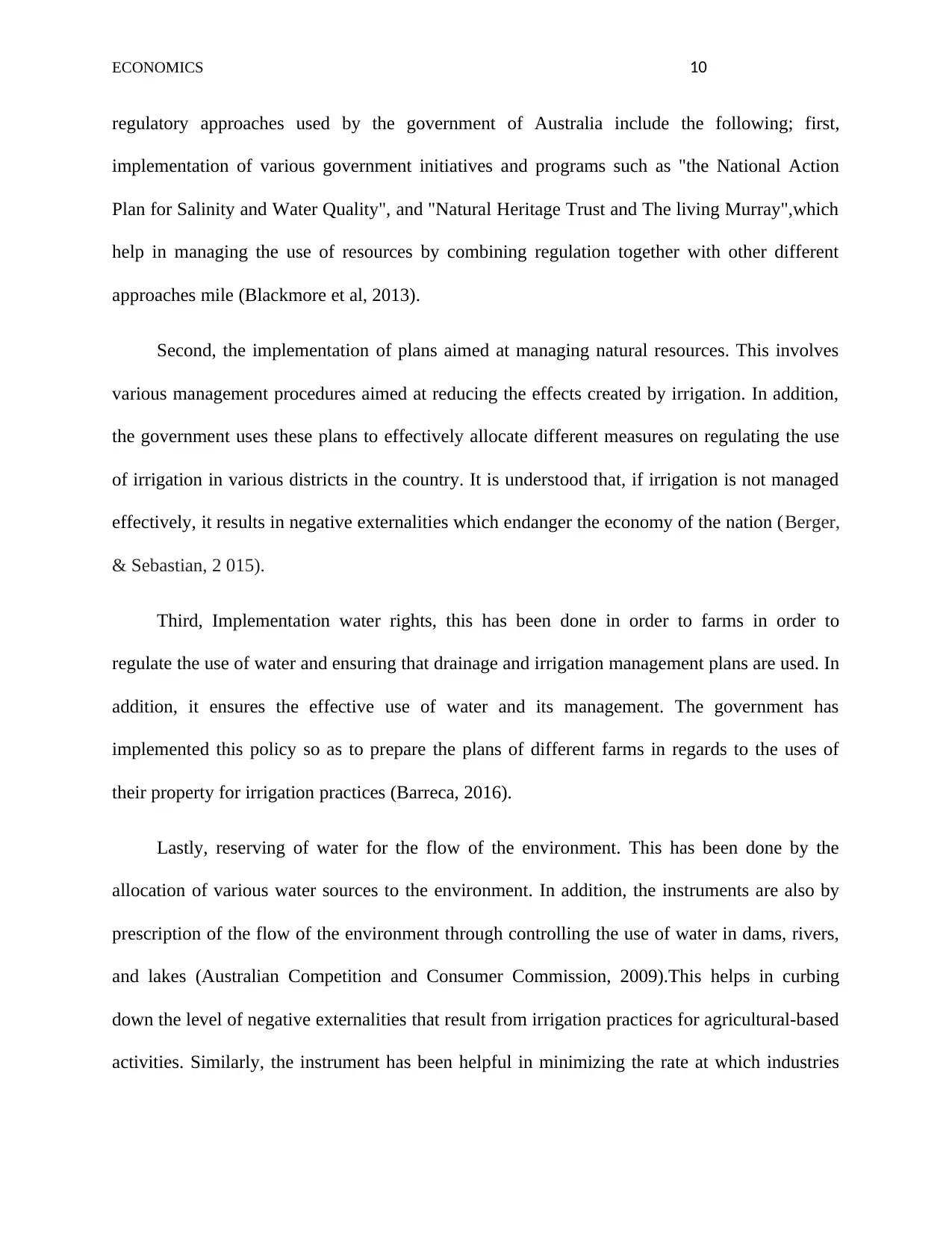
ECONOMICS 10
regulatory approaches used by the government of Australia include the following; first,
implementation of various government initiatives and programs such as "the National Action
Plan for Salinity and Water Quality", and "Natural Heritage Trust and The living Murray",which
help in managing the use of resources by combining regulation together with other different
approaches mile (Blackmore et al, 2013).
Second, the implementation of plans aimed at managing natural resources. This involves
various management procedures aimed at reducing the effects created by irrigation. In addition,
the government uses these plans to effectively allocate different measures on regulating the use
of irrigation in various districts in the country. It is understood that, if irrigation is not managed
effectively, it results in negative externalities which endanger the economy of the nation (Berger,
& Sebastian, 2 015).
Third, Implementation water rights, this has been done in order to farms in order to
regulate the use of water and ensuring that drainage and irrigation management plans are used. In
addition, it ensures the effective use of water and its management. The government has
implemented this policy so as to prepare the plans of different farms in regards to the uses of
their property for irrigation practices (Barreca, 2016).
Lastly, reserving of water for the flow of the environment. This has been done by the
allocation of various water sources to the environment. In addition, the instruments are also by
prescription of the flow of the environment through controlling the use of water in dams, rivers,
and lakes (Australian Competition and Consumer Commission, 2009).This helps in curbing
down the level of negative externalities that result from irrigation practices for agricultural-based
activities. Similarly, the instrument has been helpful in minimizing the rate at which industries
regulatory approaches used by the government of Australia include the following; first,
implementation of various government initiatives and programs such as "the National Action
Plan for Salinity and Water Quality", and "Natural Heritage Trust and The living Murray",which
help in managing the use of resources by combining regulation together with other different
approaches mile (Blackmore et al, 2013).
Second, the implementation of plans aimed at managing natural resources. This involves
various management procedures aimed at reducing the effects created by irrigation. In addition,
the government uses these plans to effectively allocate different measures on regulating the use
of irrigation in various districts in the country. It is understood that, if irrigation is not managed
effectively, it results in negative externalities which endanger the economy of the nation (Berger,
& Sebastian, 2 015).
Third, Implementation water rights, this has been done in order to farms in order to
regulate the use of water and ensuring that drainage and irrigation management plans are used. In
addition, it ensures the effective use of water and its management. The government has
implemented this policy so as to prepare the plans of different farms in regards to the uses of
their property for irrigation practices (Barreca, 2016).
Lastly, reserving of water for the flow of the environment. This has been done by the
allocation of various water sources to the environment. In addition, the instruments are also by
prescription of the flow of the environment through controlling the use of water in dams, rivers,
and lakes (Australian Competition and Consumer Commission, 2009).This helps in curbing
down the level of negative externalities that result from irrigation practices for agricultural-based
activities. Similarly, the instrument has been helpful in minimizing the rate at which industries
Paraphrase This Document
Need a fresh take? Get an instant paraphrase of this document with our AI Paraphraser
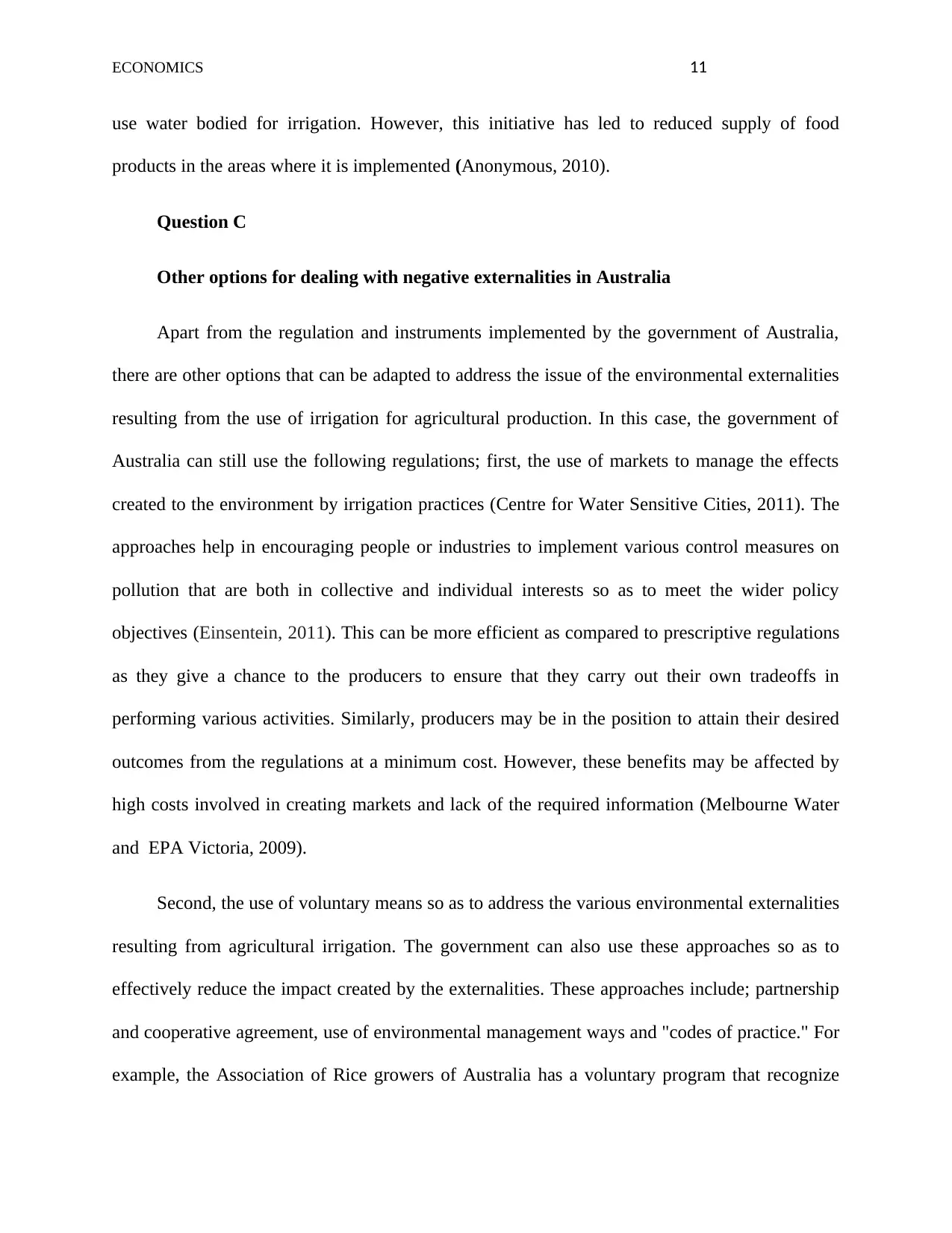
ECONOMICS 11
use water bodied for irrigation. However, this initiative has led to reduced supply of food
products in the areas where it is implemented (Anonymous, 2010).
Question C
Other options for dealing with negative externalities in Australia
Apart from the regulation and instruments implemented by the government of Australia,
there are other options that can be adapted to address the issue of the environmental externalities
resulting from the use of irrigation for agricultural production. In this case, the government of
Australia can still use the following regulations; first, the use of markets to manage the effects
created to the environment by irrigation practices (Centre for Water Sensitive Cities, 2011). The
approaches help in encouraging people or industries to implement various control measures on
pollution that are both in collective and individual interests so as to meet the wider policy
objectives (Einsentein, 2011). This can be more efficient as compared to prescriptive regulations
as they give a chance to the producers to ensure that they carry out their own tradeoffs in
performing various activities. Similarly, producers may be in the position to attain their desired
outcomes from the regulations at a minimum cost. However, these benefits may be affected by
high costs involved in creating markets and lack of the required information (Melbourne Water
and EPA Victoria, 2009).
Second, the use of voluntary means so as to address the various environmental externalities
resulting from agricultural irrigation. The government can also use these approaches so as to
effectively reduce the impact created by the externalities. These approaches include; partnership
and cooperative agreement, use of environmental management ways and "codes of practice." For
example, the Association of Rice growers of Australia has a voluntary program that recognize
use water bodied for irrigation. However, this initiative has led to reduced supply of food
products in the areas where it is implemented (Anonymous, 2010).
Question C
Other options for dealing with negative externalities in Australia
Apart from the regulation and instruments implemented by the government of Australia,
there are other options that can be adapted to address the issue of the environmental externalities
resulting from the use of irrigation for agricultural production. In this case, the government of
Australia can still use the following regulations; first, the use of markets to manage the effects
created to the environment by irrigation practices (Centre for Water Sensitive Cities, 2011). The
approaches help in encouraging people or industries to implement various control measures on
pollution that are both in collective and individual interests so as to meet the wider policy
objectives (Einsentein, 2011). This can be more efficient as compared to prescriptive regulations
as they give a chance to the producers to ensure that they carry out their own tradeoffs in
performing various activities. Similarly, producers may be in the position to attain their desired
outcomes from the regulations at a minimum cost. However, these benefits may be affected by
high costs involved in creating markets and lack of the required information (Melbourne Water
and EPA Victoria, 2009).
Second, the use of voluntary means so as to address the various environmental externalities
resulting from agricultural irrigation. The government can also use these approaches so as to
effectively reduce the impact created by the externalities. These approaches include; partnership
and cooperative agreement, use of environmental management ways and "codes of practice." For
example, the Association of Rice growers of Australia has a voluntary program that recognize
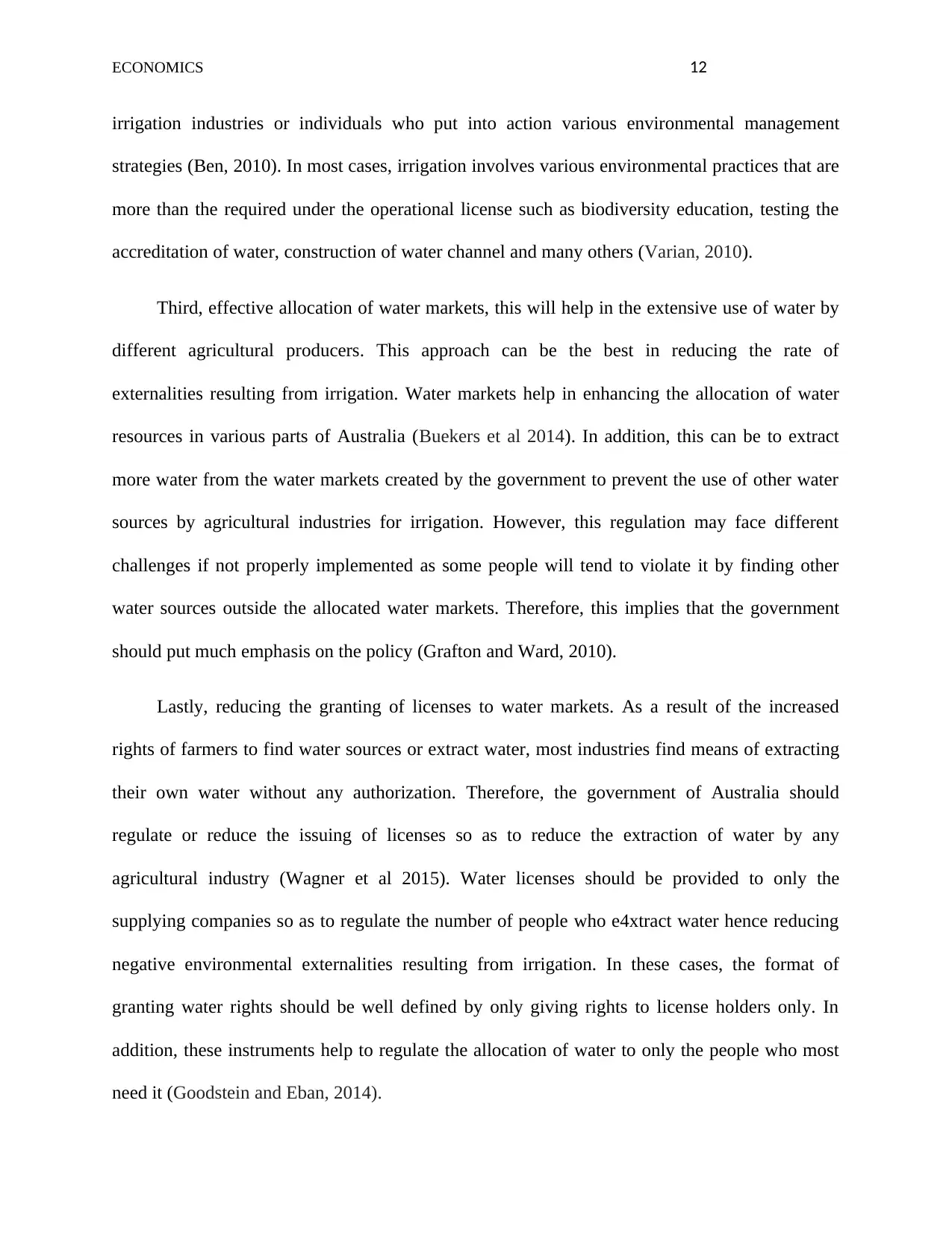
ECONOMICS 12
irrigation industries or individuals who put into action various environmental management
strategies (Ben, 2010). In most cases, irrigation involves various environmental practices that are
more than the required under the operational license such as biodiversity education, testing the
accreditation of water, construction of water channel and many others (Varian, 2010).
Third, effective allocation of water markets, this will help in the extensive use of water by
different agricultural producers. This approach can be the best in reducing the rate of
externalities resulting from irrigation. Water markets help in enhancing the allocation of water
resources in various parts of Australia (Buekers et al 2014). In addition, this can be to extract
more water from the water markets created by the government to prevent the use of other water
sources by agricultural industries for irrigation. However, this regulation may face different
challenges if not properly implemented as some people will tend to violate it by finding other
water sources outside the allocated water markets. Therefore, this implies that the government
should put much emphasis on the policy (Grafton and Ward, 2010).
Lastly, reducing the granting of licenses to water markets. As a result of the increased
rights of farmers to find water sources or extract water, most industries find means of extracting
their own water without any authorization. Therefore, the government of Australia should
regulate or reduce the issuing of licenses so as to reduce the extraction of water by any
agricultural industry (Wagner et al 2015). Water licenses should be provided to only the
supplying companies so as to regulate the number of people who e4xtract water hence reducing
negative environmental externalities resulting from irrigation. In these cases, the format of
granting water rights should be well defined by only giving rights to license holders only. In
addition, these instruments help to regulate the allocation of water to only the people who most
need it (Goodstein and Eban, 2014).
irrigation industries or individuals who put into action various environmental management
strategies (Ben, 2010). In most cases, irrigation involves various environmental practices that are
more than the required under the operational license such as biodiversity education, testing the
accreditation of water, construction of water channel and many others (Varian, 2010).
Third, effective allocation of water markets, this will help in the extensive use of water by
different agricultural producers. This approach can be the best in reducing the rate of
externalities resulting from irrigation. Water markets help in enhancing the allocation of water
resources in various parts of Australia (Buekers et al 2014). In addition, this can be to extract
more water from the water markets created by the government to prevent the use of other water
sources by agricultural industries for irrigation. However, this regulation may face different
challenges if not properly implemented as some people will tend to violate it by finding other
water sources outside the allocated water markets. Therefore, this implies that the government
should put much emphasis on the policy (Grafton and Ward, 2010).
Lastly, reducing the granting of licenses to water markets. As a result of the increased
rights of farmers to find water sources or extract water, most industries find means of extracting
their own water without any authorization. Therefore, the government of Australia should
regulate or reduce the issuing of licenses so as to reduce the extraction of water by any
agricultural industry (Wagner et al 2015). Water licenses should be provided to only the
supplying companies so as to regulate the number of people who e4xtract water hence reducing
negative environmental externalities resulting from irrigation. In these cases, the format of
granting water rights should be well defined by only giving rights to license holders only. In
addition, these instruments help to regulate the allocation of water to only the people who most
need it (Goodstein and Eban, 2014).
⊘ This is a preview!⊘
Do you want full access?
Subscribe today to unlock all pages.

Trusted by 1+ million students worldwide
1 out of 16
Related Documents
Your All-in-One AI-Powered Toolkit for Academic Success.
+13062052269
info@desklib.com
Available 24*7 on WhatsApp / Email
![[object Object]](/_next/static/media/star-bottom.7253800d.svg)
Unlock your academic potential
Copyright © 2020–2025 A2Z Services. All Rights Reserved. Developed and managed by ZUCOL.





